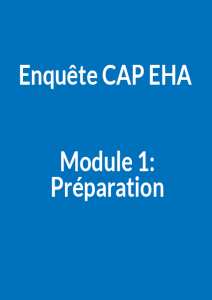 |
Enquête CAP EHA: PréparationÉditeur: UNHCR An: 2018 |
 |
Enquête CAP EHA: Prise en mainÉditeur: UNHCR An: 2017
|
 |
F-10/2015a UNHCR WASH Safety and Security Checklist (UNHCR, 2015)This document has been designed to help UNHCR and WASH actors assess potential WASH related safety and security issues related to trip, crush, pinch, pierce, cut, splinter, burn, poison, electrocution, road traffic accident, drowning, and gender based violence.
|
 |
F-11/2015a UNHCR WASH Universal Access Checklist (UNHCR, 2015)This document has been designed to help UNHCR and WASH actors assess WASH infrastructure for potential access from the individual perspective of each type of vulnerable user in particular persons with disabilities, women, children, and the elderly. |
 |
F-12/2015a UNHCR WASH Organisational Capacity Assessment (UNHCR, 2015)This tool has been designed to help obtain a snapshot capacity of national public, private, or refugee-based WASH service providers and understand the type of interventions that can be carried out to build capacity.
|
 |
F-14/2015a UNHCR Site Level Refugee WASH Strategy Template (UNHCR, 2015)Where required, UNHCR and WASH actors should work together to develop a site level refugee WASH strategy document that clearly describes the refugee context, the baseline WASH situation, WASH coverage, WASH gaps, along with short (6 months), medium (6 months – 5 years) and long-term (>5 years) strategies for each of the WASH sub-sectors and the twelve (12) WASH principles. This template can be used to help produce the site level WASH Strategy. |
 |
F-16/2015a UNHCR WASH Related Environmental Impact Assessment Template (UNHCR, 2015)Where required, UNHCR and WASH actors should prepare a WASH related environmental impact assessment. This template should be used to assist in the process. |
 |
F-50/2015a UNHCR Solid Waste Composition Assessment Template (UNHCR, 2015)UNHCR field staff and their partners should conduct a waste composition assessment to assess the types of waste being produced and their and rates of production. Ideally the assessment should be carried out within the first three months of a displacement emergency and then at least once a year. Waste management short, medium and long term strategies for each waste stream should be revaluated and reorganised according to the findings of this assessment. |
 |
F-51/2015a UNHCR Landfill Sanitary Survey Form (UNHCR, 2015)This form can be used to assess the refugee landfill site for public health and environmental sanitary risk factors.
|
